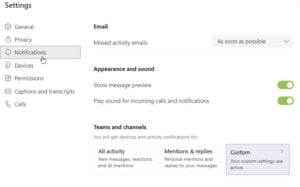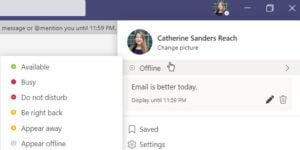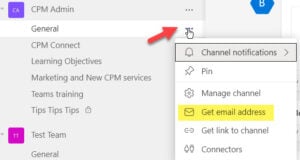Notifications in MS Teams
If your firm has started using Microsoft Teams you will want to make sure you do not miss something important. There are many settings you can customize to get notifications in the app and via email so you can keep up with important messages and events even if you are not logged into Teams.
Settings
 In MS Teams go to your avatar in the upper right corner and select “Settings” from the drop-down menu. Under Notifications there are lots of options. At the top under Email you can set up how often you get an email notification when anything appears in your activity feed. You can choose “as soon as possible” or get a digest at different intervals. Note that you will only get an email notification if Teams is turned off – otherwise new activity will appear as a message preview and will play a sound. However, if you do not want a sound or preview go to the next section in Notifications and toggle those options on or off.
In MS Teams go to your avatar in the upper right corner and select “Settings” from the drop-down menu. Under Notifications there are lots of options. At the top under Email you can set up how often you get an email notification when anything appears in your activity feed. You can choose “as soon as possible” or get a digest at different intervals. Note that you will only get an email notification if Teams is turned off – otherwise new activity will appear as a message preview and will play a sound. However, if you do not want a sound or preview go to the next section in Notifications and toggle those options on or off.
Under Teams and Channels in the Notifications settings you can get granular about what triggers a notification. If you participate in a busy channel you may choose to only get notified of chat replies, mentions or reactions, or meeting reminders.
Status and Status Notifications
 By default, Teams marks your status based on your availability in your MS Outlook calendar, so that other people in Teams can see whether you are available to call or meet. However, if you need to change that status from “available” to “busy” or even just appear like you are away just click on your avatar in the upper right corner of Teams and click “status” to choose from many options. You can also set up a custom status like “Email is the best way to reach me today”.
By default, Teams marks your status based on your availability in your MS Outlook calendar, so that other people in Teams can see whether you are available to call or meet. However, if you need to change that status from “available” to “busy” or even just appear like you are away just click on your avatar in the upper right corner of Teams and click “status” to choose from many options. You can also set up a custom status like “Email is the best way to reach me today”.
Do you want to track the status of a colleague? In Settings under Notifications look at
“People” and click Edit. You can add a person on your team to get notifications when they appear available or offline.
You can also turn on Do Not Disturb as a status but allow notifications from people with priority access to get through. In Settings under Privacy click on Manage Priority Access under Do Not Disturb. Add the name or names of the people you want to allow notifications for chats, calls, and @mentions.
Teams Meetings
Whether you schedule a Teams meeting from within MS Outlook (click on “New Items” and choose Teams meeting or from within your calendar click on the New Teams Meeting button) or set up a new meeting from anywhere in MS Teams, the meeting information will automatically be added to your personal Outlook calendar. The default reminder for the event is 15 minutes. While you can adjust the reminder time in the event in MS Outlook’s calendar you cannot through Teams calendar view. Reminders about the meeting will come from Outlook, not from Teams.
If you schedule a meeting for a Teams Channel the meeting will appear on your Outlook calendar, as well as appearing as a post in the Channel.
Email To and From Team Channels
 While not technically a notification, sometimes you may want to send an email from your Outlook inbox (or any email account) to a Team channel to share with teammates and save it in the Channel posts. For any Channel in a Team workspace click on the ellipses then choose “get email address”. You can copy the email address and then forward an email to it or reply to an email and cc the Channel Email address. The email will appear in the Channel posts. The Channel email address is always the same so you can add it to your contacts and set up Outlook rules with it, for instance “if I get an email from Sue Jones forward it to the channel email address”.
While not technically a notification, sometimes you may want to send an email from your Outlook inbox (or any email account) to a Team channel to share with teammates and save it in the Channel posts. For any Channel in a Team workspace click on the ellipses then choose “get email address”. You can copy the email address and then forward an email to it or reply to an email and cc the Channel Email address. The email will appear in the Channel posts. The Channel email address is always the same so you can add it to your contacts and set up Outlook rules with it, for instance “if I get an email from Sue Jones forward it to the channel email address”.
Interestingly, anyone who has the email address for the Team channel can send emails to that address. You could give it to a client, and they could cc the Channel when they correspond with you. If the open nature of the channel email address makes you nervous go back to the ellipses for the Channel, click “Get email address” and click remove email address. Once you take this action it cannot be undone.
If you want to send a post/activity from a Teams channel via email to someone then mouse over the post so that options appear to the right. Click the ellipses and choose “Share to Outlook”. When you click Share to Outlook a small Outlook window appears (from Outlook online) and you can forward the post to any email address.
Automations
In addition to using Rules in Microsoft Outlook to automate emailing to a Teams channel, there are many templates in MS Power Automate to help you move information from Outlook to Teams or trigger actions and notifications. To get some ideas go to Power Automate and, in the templates, search for Teams. You can set up flows to save attachments to emails to a Teams Channel files tab, get push notifications for various Teams activities, get email notifications for activities in Teams, and much more. For instance, send an email when a new message is added in Teams, post a message to Teams when an email arrives in Outlook, or alert the team when specific documents are uploaded.
Conclusion
With notifications, alerts, email and calendar integrations you can make sure to incorporate Teams into your workflow more effectively. You can set the tools you use in MS 365 to let you work the way that you do and never miss an important message – no matter where it appears.